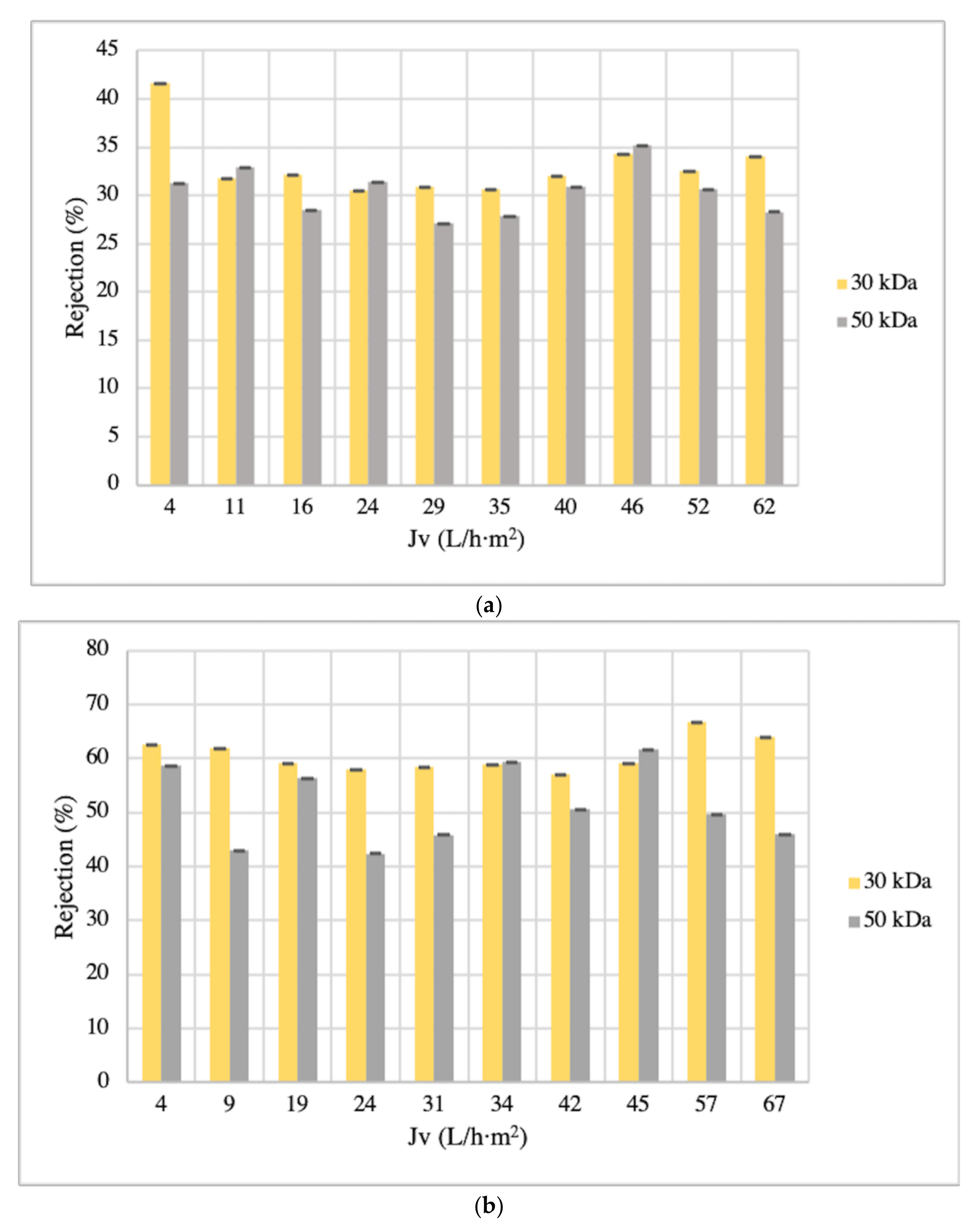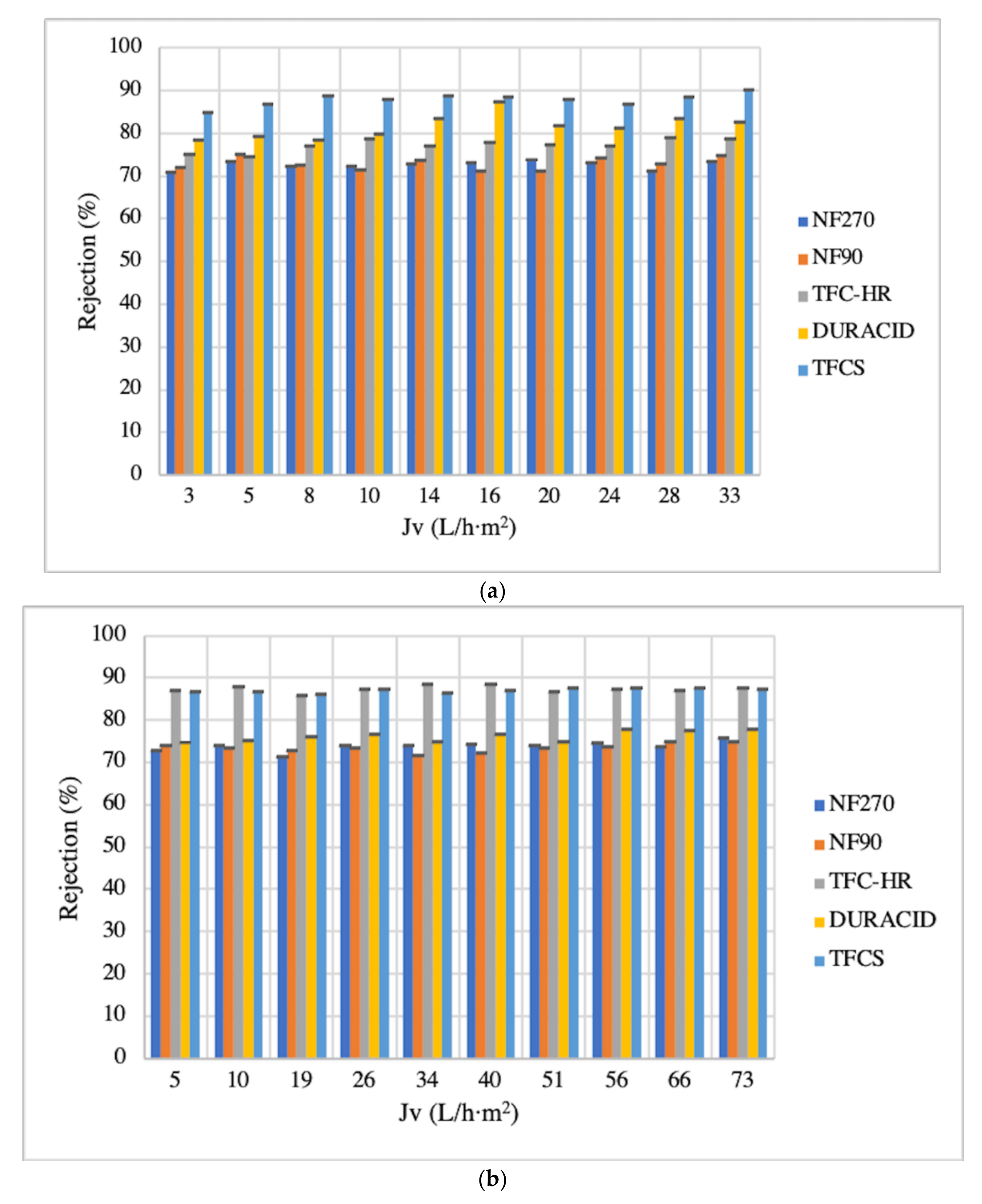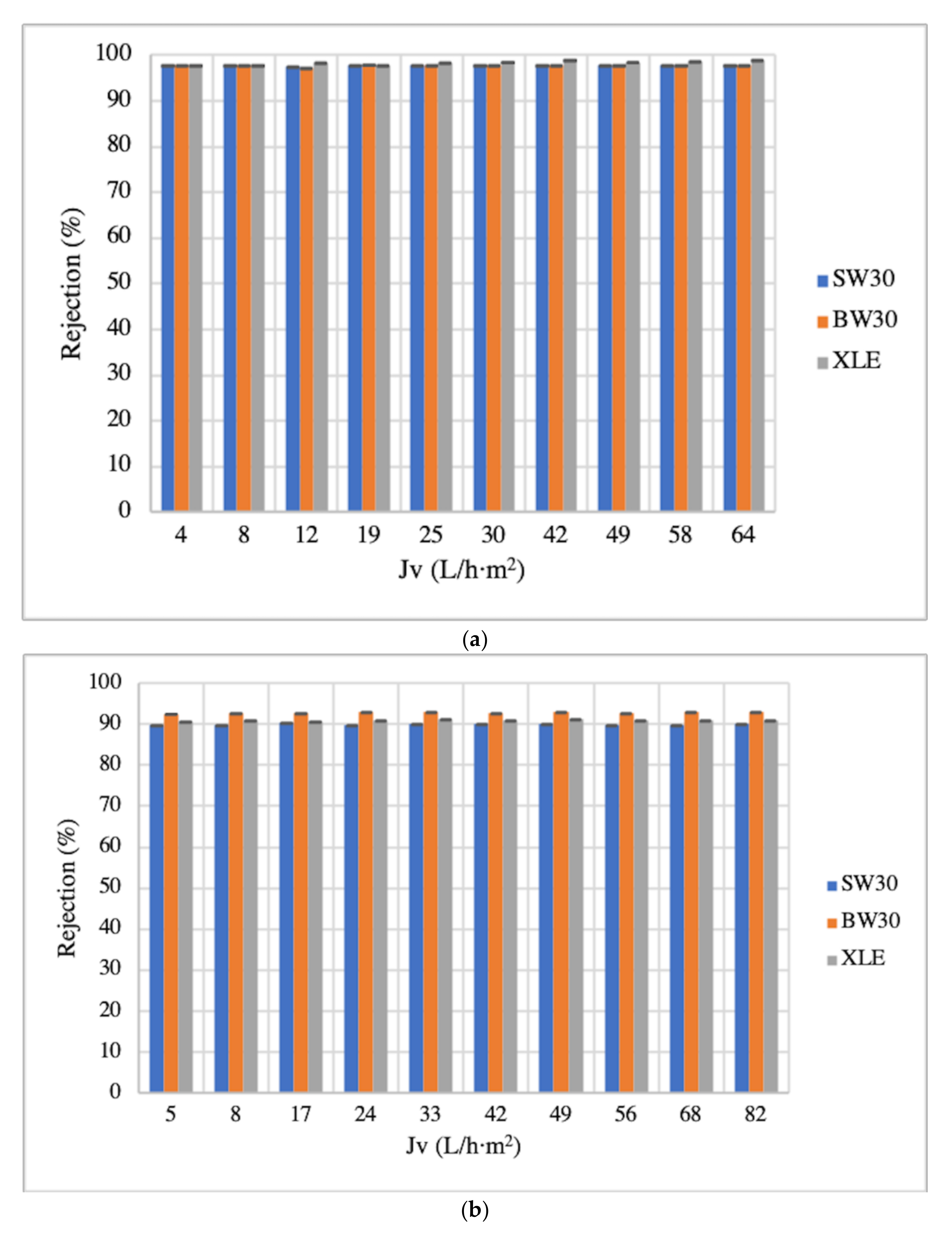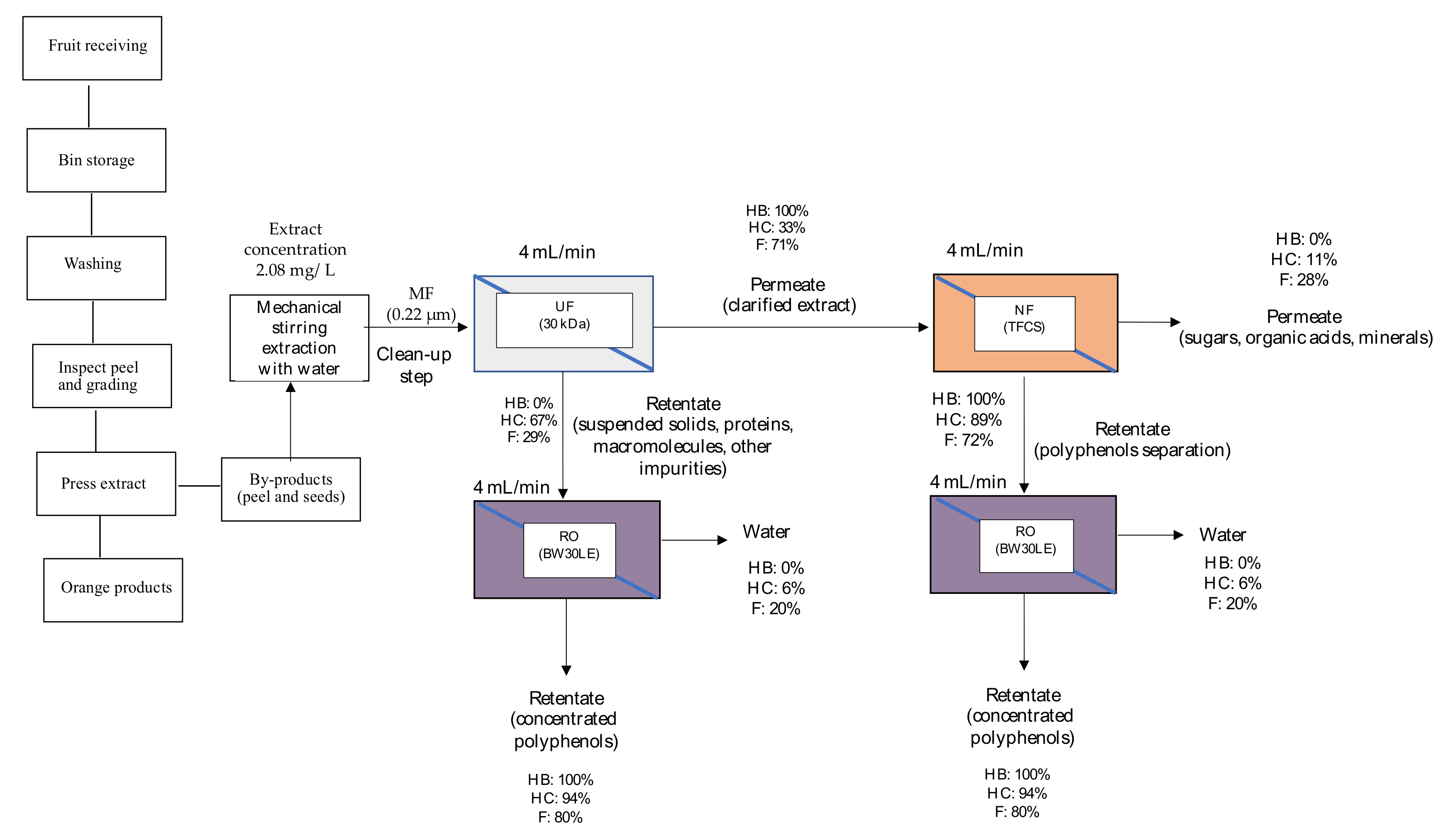Recovery of Natural Polyphenols from Spinach and Orange By-Products by Pressure-Driven Membrane Processes
Abstract
:1. Introduction
2. Materials and Methods
2.1. Reagents
2.2. Samples
2.3. Extraction Process
2.4. Polyphenol Separation and Concentration by the Membrane Process
2.4.1. Experimental Set-Up and Procedures
2.4.2. Membrane Tests
2.5. HPLC Determination of TPC
2.6. Statistical Analysis
3. Results and Discussions
3.1. Polyphenol Composition of Extracts of Spinach and Orange Wastes
3.2. Performance of Selected Membranes from Spinach and Orange Extracts
3.2.1. Microfiltration
3.2.2. Ultrafiltration
3.2.3. Nanofiltration
3.2.4. Reverse Osmosis
3.3. A Proposal for an Integrated Membrane Process for Polyphenol Separation and Concentration from Spinach and Orange Extracts
4. Conclusions
Author Contributions
Funding
Institutional Review Board Statement
Informed Consent Statement
Data Availability Statement
Acknowledgments
Conflicts of Interest
References
- Montenegro-Landívar, M.F.; Tapia-Quirós, P.; Vecino, X.; Reig, M.; Valderrama, C.; Granados, M.; Cortina, J.L.; Saurina, J. Polyphenols and their potential role to fight viral diseases: An overview. Sci. Total Environ. 2021, 801, 149719. [Google Scholar] [CrossRef]
- Melgar, B.; Dias, M.I.; Ciric, A.; Sokovic, M.; Garcia-Castello, E.M.; Rodriguez-Lopez, A.D.; Barros, L.; Ferreira, I.C.R.F. Bioactive characterization of Persea americana Mill. by-products: A rich source of inherent antioxidants. Ind. Crops Prod. 2018, 111, 212–218. [Google Scholar] [CrossRef] [Green Version]
- Ruby-Figueroa, R.; Cassano, A.; Drioli, E. Ultrafiltration of orange press liquor: Optimization of operating conditions for the recovery of antioxidant compounds by response surface methodology. Sep. Purif. Technol. 2012, 98, 255–261. [Google Scholar] [CrossRef]
- Conidi, C.; Drioli, E.; Cassano, A. Membrane-based agro-food production processes for polyphenol separation, purification and concentration. Curr. Opin. Food Sci. 2017, 23, 149–164. [Google Scholar] [CrossRef]
- Farhoosh, R.; Johnny, S.; Asnaashari, M.; Molaahmadibahraseman, N.; Sharif, A. Structure-antioxidant activity relationships of o-hydroxyl, o-methoxy, and alkyl ester derivatives of p-hydroxybenzoic acid. Food Chem. 2016, 194, 128–134. [Google Scholar] [CrossRef]
- Montenegro-Landívar, M.F.; Tapia-Quirós, P.; Vecino, X.; Reig, M.; Valderrama, C.; Granados, M.; Cortina, J.L.; Saurina, J. Recovery of added-value compounds from orange and spinach processing residues: Green extraction of phenolic compounds and evaluation of antioxidant activity. Antioxidants 2021, 10, 1800. [Google Scholar] [CrossRef]
- Montenegro-Landívar, M.F.; Tapia-Quirós, P.; Vecino, X.; Reig, M.; Valderrama, C.; Granados, M.; Cortina, J.L.; Saurina, J. Fruit and vegetable processing wastes as natural sources of antioxidant-rich extracts: Evaluation of advanced extraction technologies by surface response methodology. J. Environ. Chem. Eng. 2021, 9, 105330. [Google Scholar] [CrossRef]
- Al-Juhaimi, F.Y. Citrus fruits by-products as sources of bioactive compounds with antioxidant potential. Pak. J. Bot. 2014, 46, 1459–1462. [Google Scholar]
- Zhang, L.; Zhu, M.; Shi, T.; Guo, C.; Huang, Y.; Chen, Y.; Xie, M. Recovery of dietary fiber and polyphenol from grape juice pomace and evaluation of their functional properties and polyphenol compositions. Food Funct. 2017, 8, 341–351. [Google Scholar] [CrossRef]
- Myburgh, K.H. Polyphenol supplementation: Benefits for exercise performance or oxidative stress? Sport. Med. 2014, 44, S57–S70. [Google Scholar] [CrossRef] [Green Version]
- Ameer, K.; Shahbaz, H.M.; Kwon, J.H. Green Extraction Methods for Polyphenols from Plant Matrices and Their Byproducts: A Review. Compr. Rev. Food Sci. Food Saf. 2017, 16, 295–315. [Google Scholar] [CrossRef] [PubMed] [Green Version]
- Cassano, A.; Conidi, C.; Ruby-Figueroa, R. Recovery of flavonoids from orange press liquor by an integrated membrane process. Membranes 2014, 4, 509–524. [Google Scholar] [CrossRef] [PubMed] [Green Version]
- Tapia-Quirós, P.; Montenegro-Landívar, M.F.; Reig, M.; Vecino, X.; Saurina, J.; Granados, M.; Cortina, J.L. Integration of membrane processes for the recovery and separation of polyphenols from winery and olive mill wastes using green solvent-based processing. J. Environ. Manag. 2022, 307, 114555. [Google Scholar] [CrossRef] [PubMed]
- Cassano, A.; De Luca, G.; Conidi, C.; Drioli, E. Effect of polyphenols-membrane interactions on the performance of membrane-based processes. A review. Coord. Chem. Rev. 2017, 351, 45–75. [Google Scholar] [CrossRef]
- Pap, N.; Mahosenaho, M.; Pongrácz, E.; Mikkonen, H.; Jaakkola, M.; Virtanen, V.; Myllykoski, L.; Horváth-Hovorka, Z.; Hodúr, C.; Vatai, G.; et al. Effect of Ultrafiltration on Anthocyanin and Flavonol Content of Black Currant Juice (Ribes nigrum L.). Food Bioprocess Technol. 2012, 5, 921–928. [Google Scholar] [CrossRef]
- Cassano, A.; Conidi, C.; Drioli, E. Clarification and concentration of pomegranate juice (Punica granatum L.) using membrane processes. J. Food Eng. 2011, 107, 366–373. [Google Scholar] [CrossRef]
- Cassano, A.; Tasselli, F.; Conidi, C.; Drioli, E. Ultrafiltration of Clementine mandarin juice by hollow fibre membranes. Desalination 2009, 241, 302–308. [Google Scholar] [CrossRef]
- Pinto, P.C.R.; Mota, I.F.; Loureiro, J.M.; Rodrigues, A.E. Membrane performance and application of ultrafiltration and nanofiltration to ethanol/water extract of Eucalyptus bark. Sep. Purif. Technol. 2014, 132, 234–243. [Google Scholar] [CrossRef]
- Conidi, C.; Cassano, A.; Caiazzo, F.; Drioli, E. Separation and purification of phenolic compounds from pomegranate juice by ultrafiltration and nanofiltration membranes. J. Food Eng. 2017, 195, 1–13. [Google Scholar] [CrossRef]
- Filter-Lab 0.22 µm. Available online: https://fanoia.com/en/filtros-membrana/filtros-membrana-esteres-mixtos-de-celulosa-mce/ (accessed on 8 June 2021).
- McCloskey, B.D.; Park, H.B.; Ju, H.; Rowe, B.W.; Miller, D.J.; Chun, B.J.; Kin, K.; Freeman, B.D. Influence of polydopamine deposition conditions on pure water flux and foulant adhesion resistance of reverse osmosis, ultrafiltration, and microfiltration membranes. Polymer 2010, 51, 3472–3485. [Google Scholar] [CrossRef]
- Filter-Lab 0.45 µm. Available online: https://fanoia.com/en/filtros-membrana/filtros-membrana-esteres-mixtos-de-celulosa-mce/ (accessed on 8 June 2021).
- Conidi, C.; Mazzei, R.; Cassano, A.; Giorno, L. Integrated membrane system for the production of phytotherapics from olive mill wastewaters. J. Membr. Sci. 2014, 454, 322–329. [Google Scholar] [CrossRef]
- Biomax 30 kDa. Available online: https://www.merckmillipore.com/ES/es/product/Ultrafiltration-Discs-30kDa-NMW,MM_NF-PBTK07610.%0A (accessed on 8 June 2021).
- Marson, G.V.; Pereira, D.T.V.; da Costa Machado, M.T.; Di Luccio, M.; Martínez, J.; Belleville, M.P.; Hubinger, M.D. Ultrafiltration performance of spent brewer’s yeast protein hydrolysate: Impact of pH and membrane material on fouling. J. Food Eng. 2021, 302, 110569. [Google Scholar] [CrossRef]
- Wu, N.; Wyart, Y.; Siozade, L.; Georges, G.; Moulin, P. Characterization of ultrafiltration membranes fouled by quantum dots by confocal laser scanning microscopy. J. Membr. Sci. 2014, 470, 40–51. [Google Scholar] [CrossRef]
- Biomax 50 kDa. Available online: https://www.merckmillipore.com/ES/es/product/Ultrafiltration-Discs-50kDa-NMW,MM_NF-PBQK07610 (accessed on 8 June 2021).
- Bhattacharjee, C.; Saxena, V.K.; Dutta, S. Analysis of fouling and juice quality in crossflow ultrafiltration of watermelon juice. Food Sci. Technol. 2018, 38, 71–76. [Google Scholar] [CrossRef] [Green Version]
- Yue, C.; Dong, H.; Chen, Y.; Shang, B.; Wang, Y.; Wang, S.; Zhu, Z. Direct purification of digestate using ultrafiltration membranes: Influence of pore size on filtration behavior and fouling characteristics. Membranes 2021, 11, 179. [Google Scholar] [CrossRef]
- DuPont-FilmTecTM NF90-4040. Available online: https://www.dupont.com/products/filmtecnf904040.html (accessed on 8 June 2021).
- Foureaux, A.F.S.; Reis, E.O.; Lebron, Y.; Moreira, V.; Santos, L.V.; Amaral, M.S.; Lange, L.C. Rejection of pharmaceutical compounds from surface water by nanofiltration and reverse osmosis. Sep. Purif. Technol. 2019, 212, 171–179. [Google Scholar] [CrossRef] [Green Version]
- Licona, K.P.M.; Geaquinto, L.R.d.O.; Nicolini, J.V.; Figueiredo, N.G.; Chiapetta, S.C.; Habert, A.C.; Yokoyama, L. Assessing potential of nanofiltration and reverse osmosis for removal of toxic pharmaceuticals from water. J. Water Process Eng. 2018, 25, 195–204. [Google Scholar] [CrossRef]
- Leo, C.P.; Yahya, M.Z.; Kamal, S.N.M.; Ahmad, A.L.; Mohammad, A.W. Potential of nanofiltration and low pressure reverse osmosis in the removal of phosphorus for aquaculture. Water Sci. Technol. 2013, 67, 831–837. [Google Scholar] [CrossRef]
- Lin, Y.L. Effects of organic, biological and colloidal fouling on the removal of pharmaceuticals and personal care products by nanofiltration and reverse osmosis membranes. J. Membr. Sci. 2017, 542, 342–351. [Google Scholar] [CrossRef]
- DuPont-FilmTecTM NF270-4040. Available online: https://www.dupont.com/products/filmtecnf2704040.html (accessed on 8 June 2021).
- Schütte, T.; Niewersch, C.; Wintgens, T.; Yüce, S. Phosphorus recovery from sewage sludge by nanofiltration in diafiltration mode. J. Membr. Sci. 2015, 480, 74–82. [Google Scholar] [CrossRef]
- SUEZ NF Duracid. Available online: https://legacy.suezwatertechnologies.com/index.html?DN=FSsmDuracid_EN.pdf (accessed on 27 November 2021).
- López, J.; Gibert, O.; Cortina, J.L. Evaluation of an extreme acid-resistant sulphonamide based nanofiltration membrane for the valorisation of copper acidic effluents. Chem. Eng. J. 2021, 405, 127015. [Google Scholar] [CrossRef]
- KOCH-Fluid Systems NF TFCS. Available online: https://www.kochseparation.com/wp-content/uploads/2020/10/Fluid-System-TFC-SR-4-inch-element.pdf (accessed on 27 November 2021).
- KOCH-Fluid Systems NF TFC-HR. Available online: https://www.kochseparation.com/wp-content/uploads/2020/10/Fluid-Systems-TFC-HR-4-inch-brackish-water-RO-element.pdf (accessed on 27 November 2021).
- DuPont FilmTecTM SW30-4040. Available online: https://www.dupont.com/products/filmtecsw304040.html (accessed on 27 November 2021).
- Saki, S.; Uzal, N. Surface coating of polyamide reverse osmosis membranes with zwitterionic 3-(3,4-dihydroxyphenyl)-l-alanine (l-DOPA) for forward osmosis. Water Environ. J. 2020, 34, 400–412. [Google Scholar] [CrossRef]
- Li, Q.; Song, J.; Yu, H.; Li, Z.; Pan, X.; Yang, B. Investigating the microstructures and surface features of seawater RO membranes and the dependencies of fouling resistance performances. Desalination 2014, 352, 109–117. [Google Scholar] [CrossRef]
- Chau, H.W.; Biswas, A.; Vujanovic, V.; Si, B.C. Relationship between the severity, persistence of soil water repellency and the critical soil water content in water repellent soils. Geoderma 2014, 221–222, 113–120. [Google Scholar] [CrossRef]
- DuPont FilmTecTM BW30-4040. Available online: https://www.dupont.com/products/filmtecbw304040.html (accessed on 27 November 2021).
- Zhao, Y.; Dai, L.; Zhang, Q.; Zhang, S. Surface modification of polyamide reverses osmosis membrane by phosphonic acid group with improved performance. J. Appl. Polym. Sci. 2019, 136, 46931. [Google Scholar] [CrossRef]
- DuPont-FilmTecTM XLE-4040. Available online: https://www.dupont.com/products/filmtecxle4040.html (accessed on 27 November 2021).
- Li, H.; Peng, L.; Luo, Y.; Yu, P. Enhancement in membrane performances of a commercial polyamide reverse osmosis membrane via surface coating of polydopamine followed by the grafting of polyethylenimine. RSC Adv. 2015, 5, 98566–98575. [Google Scholar] [CrossRef]
- Cassano, A.; Conidi, C.; Ruby-Figueroa, R.; Castro-Muñoz, R. Nanofiltration and tight ultrafiltration membranes for the recovery of polyphenols from agro-food by-products. Int. J. Mol. Sci. 2018, 19, 351. [Google Scholar] [CrossRef] [PubMed] [Green Version]
- Chandra, P.N.; Mohan, M.K. Tailor-Made Polyelectrolyte Multilayers for the Removal of Obidoxime from Water in Microfiltration Process. Membr. Membr. Technol. 2020, 2, 132–147. [Google Scholar] [CrossRef] [Green Version]
- Ahmad, A.L.; Mat Yasin, N.H.; Derek, C.J.C.; Lim, J.K. Microfiltration of chlorella sp.: Influence of material and membrane pore size. Membr. Water Treat. 2013, 4, 143–155. [Google Scholar] [CrossRef]
- Ahmad, A.L.; Sunarti, A.R.; Lee, K.T.; Fernando, W.J.N. CO2 removal using membrane gas absorption. Int. J. Greenh. Gas Control 2010, 4, 495–498. [Google Scholar] [CrossRef]
- Comite, A.; Basile, A. Membrane Technology for Water and Wastewater Treatment—Advances and Emerging Processes. In Current Trends and Future Developments on (Bio-) Membranes; Elsevier: Chennai, India, 2020; ISBN 9780128168240. [Google Scholar]
- Laorko, A.; Li, Z.; Tongchitpakdee, S.; Chantachum, S.; Youravong, W. Effect of membrane property and operating conditions on phytochemical properties and permeate flux during clarification of pineapple juice. J. Food Eng. 2010, 100, 514–521. [Google Scholar] [CrossRef]
- Antónia Nunes, M.; Pawlowski, S.; Costa, A.S.G.; Alves, R.C.; Oliveira, M.B.P.P.; Velizarov, S. Valorization of olive pomace by a green integrated approach applying sustainable extraction and membrane-assisted concentration. Sci. Total Environ. 2019, 652, 40–47. [Google Scholar] [CrossRef]
- Cao, Y.; Chen, G.; Wan, Y.; Luo, J. Nanofiltration membrane for bio-separation: Process-oriented materials innovation. Eng. Life Sci. 2021, 21, 405–416. [Google Scholar] [CrossRef] [PubMed]
- Conidi, C.; Cassano, A.; Drioli, E. A membrane-based study for the recovery of polyphenols from bergamot juice. J. Membr. Sci. 2011, 375, 182–190. [Google Scholar] [CrossRef]
- Sotto, A.; Arsuaga, J.M.; Van der Bruggen, B. Sorption of phenolic compounds on NF/RO membrane surfaces: Influence on membrane performance. Desalination 2013, 309, 64–73. [Google Scholar] [CrossRef]
- Gao, L.; Wang, H.; Zhang, Y.; Wang, M. Nanofiltration membrane characterization and application: Extracting lithium in lepidolite leaching solution. Membranes 2020, 10, 178. [Google Scholar] [CrossRef] [PubMed]
- Kosmulski, M. The pH dependent surface charging and points of zero charge. VII. Update. Adv. Colloid Interface Sci. 2018, 251, 115–138. [Google Scholar] [CrossRef]
- Senit, J.J.; Velasco, D.; Gomez Manrique, A.; Sanchez-Barba, M.; Toledo, J.M.; Santos, V.E.; Garcia-Ochoa, F.; Yustos, P.; Ladero, M. Orange peel waste upstream integrated processing to terpenes, phenolics, pectin and monosaccharides: Optimization approaches. Ind. Crops Prod. 2019, 134, 370–381. [Google Scholar] [CrossRef]
- Gunathilake, K.D.P.P.; Yu, L.J.; Rupasinghe, H.P.V. Reverse osmosis as a potential technique to improve antioxidant properties of fruit juices used for functional beverages. Food Chem. 2014, 148, 335–341. [Google Scholar] [CrossRef]
- Bottino, A.; Capannelli, G.; Comite, A.; Jezowska, A.; Pagliero, M.; Costa, C.; Firpo, R. Treatment of olive mill wastewater through integrated pressure-driven membrane processes. Membranes 2020, 10, 334. [Google Scholar] [CrossRef]
- Petrotos, K.B.; Kokkora, M.I.; Papaioannou, C.; Gkoutsidis, P.E. Olive mill wastewater concentration by two-stage reverse osmosis in tubular configuration, in a scheme combining open and tight membranes. Desalin. Water Treat. 2016, 57, 20621–20630. [Google Scholar] [CrossRef]
- Conidi, C.; Cassano, A.; Garcia-Castello, E. Valorization of artichoke wastewaters by integrated membrane process. Water Res. 2014, 48, 363–374. [Google Scholar] [CrossRef] [PubMed]
- Galanakis, C.M. Recovery of high added-value components from food wastes: Conventional, emerging technologies and commercialized applications. Trends Food Sci. Technol. 2012, 26, 68–87. [Google Scholar] [CrossRef]
- Langyan, S.; Yadava, P.; Sharma, S.; Gupta, N.C.; Bansal, R.; Yadav, R.; Kalia, S.; Kumar, A. Food and nutraceutical functions of sesame oil: An underutilized crop for nutritional and health benefits. Food Chem. 2022, 389, 132990. [Google Scholar] [CrossRef] [PubMed]
- Wang, L.; Boh, T. Health-Promoting Food Ingredients and Functional Food Processing. In Nutrition, Well-Being and Health; InTech Open: Rijeka, Croatia, 2012. [Google Scholar] [CrossRef] [Green Version]
- Brglez Mojzer, E.; Knez Hrnčič, M.; Škerget, M.; Knez, Ž.; Bren, U. Polyphenols: Extraction Methods, Antioxidative Action, Bioavailability and Anticarcinogenic Effects. Molecules 2016, 21, 901. [Google Scholar] [CrossRef]
- Rodrigo, R.; Miranda, A.; Vergara, L. Modulation of endogenous antioxidant system by wine polyphenols in human disease. Clin. Chim. Acta 2011, 412, 410–424. [Google Scholar] [CrossRef]
- Löf, D.; Schillén, K.; Nilsson, L. Flavonoids: Precipitation kinetics and interaction with surfactant micelles. J. Food Sci. 2011, 76, N35–N39. [Google Scholar] [CrossRef]







| Membrane | Composition | pH Range (25 °C) | T Max (°C) | P Max (bar) | Iso-Electric Point (IEP) | Contact Angle (°) | Pore Size | MWCO 1 (Da) | Pure Water Permeability (L/m2 h bar) | Zeta Potential (mV) | Reference | |
|---|---|---|---|---|---|---|---|---|---|---|---|---|
| MF | Filter-Lab 0.22 µm | Mixed cellulose esters (MCE) | 2–10 | 75 | <1.4 | 5.5 | 31 ± 1 19 | 0.22 µm | >100,000 | 7970 ± 290 8090 ± 320 at 1 bar 3770 | −21. 1 (pH 8) −9.8 (pH 8) +20 (pH 7) | [20,21] |
| Filter-Lab 0.45 µm | Mixed cellulose esters (MCE) | 4–8 | 75 | <1.8 | 2–3.3 | 46.7 | 0.45 µm | 1260 at 0.7 bar | −22.5 (pH 7) | [22,23] | ||
| UF | Biomax 30 kDa (Merck, Darmstradt, Germany) | Polyethersulfone (PES) | 0–14 | 95 | 6 | Around 3.5 | 12 ± 2.94 | 9.61 nm | 30,000 | 390 ± 20 | −16.4 (pH 8) | [24,25,26] |
| Biomax 50 kDa (Merck, Darmstradt, Germany) | Polyethersulfone (PES) | 2–13 | 50 | 0.5–3 | 3.05 ± 0.5 | 68.7 ± 2.2 | 100 nm | 50,000 | 593.6 ± 84.5 at TMP: 3 bar | Around −15 (pH 7) | [27,28,29] | |
| NF | NF90 (DuPont, Delfgauw, Netherlands) | Uncoated fully aromatic polyamide TFC 2 | 2–11 | 45 | 41 | 4.3 4.0 | 54 62.7 41.4 63.2 83.4 | 0.68 0.24 nm | 200–400 | 10.6 | +13 (pH 3) −7 (pH 5) −24.9 (pH 7) −28 (pH 9) −29 (pH 10) | [30,31,32,33,34] |
| NF270 (DuPont, Delfgauw, Netherlands) | Uncoated semi aromatic polypiperazine amide TFC | 2–11 | 45 | 41 | 4.5 4.1 | 30 27 29 64.1 | 0.84 nm 0.71 0.42 | 200–400 | 17.8 | +7 (pH 3) −15 (pH 5) −19, −22 (pH 7) −22 (pH 9) −28 (pH 10) | [31,34,35,36] | |
| DURACID (Suez, Trevose, PA, USA) | Sulfonamide-based active layer and polysulfone support | <10 0–9 | 70 | 82 | 4.3 | 62.2 ± 4.2 | 0.47 nm | 150–300 | 8 at TMP: 7 bar 17–32 at 15.5 bar | - | [37,38] | |
| TFCS (KOCH, Cansas, USA) | Proprietary TFC® polyamide | 4–11 | 45 | 82 | 3.1 | 18.7 | - | 300 | 49 ± 6 at 5 bar | −6.5 (pH 8) | [39] | |
| TFC-HR (KOCH, Cansas, USA) | Proprietary TFC® polyamide | 4–11 | 45 | 41 | 4.7 | 35.7 | - | 300–500 | 3.5 | −9.5 (pH 7) −17 (pH 9) | [40] | |
| RO | SW30HR (DuPont, Delfgauw, Netherlands) | Coated fully aromatic polyamide TFC | 2–11 | 45 | 69 | Always negative | 52.8 Around 50 | - | 100 | 1.3 | −17.8 (pH 10.4) | [41,42,43,44] |
| BW30LE (DuPont, Delfgauw, Netherlands) | Coated fully aromatic polyamide TFC | 2–11 | 45 | 41 | 4.2 Close to 3 4.07 | 72.2 59.8 55 Around 50 (>SW30HR) | 0.32 nm | 98 100 | 2.2 | −12.8 | [31,32,45,46] | |
| XLE (DuPont, Delfgauw, Netherlands) | Uncoated fully aromatic polyamide TFC | 2–11 | 45 | 41 | 3.5 | 55 66.3 70.9 65.7 | 0.89 nm | 100 | 8.8 | +13 (pH 3) −17 (pH 5) −33 (pH 7) −38 (pH 9) −38 (pH 10) | [33,34,47,48] |
| Membrane | Retentate Stream | Permeate Stream | |||||
|---|---|---|---|---|---|---|---|
| HB | HC | F | HB | HC | F | ||
| MF | 0.22 µm | 17% | 20% | 24% | 83% | 70% | 75% |
| 0.45 µm | 12% | 14% | 21% | 88% | 86% | 79% | |
| UF | 30 kDa | 36% | 32% | 40% | 64% | 68% | 60% |
| 50 kDa | 25% | 23% | 38% | 75% | 77% | 62% | |
| NF | TFCS | 100% | 100% | 81% | 0% | 0% | 19% |
| DURACID | 100% | 90% | 73% | 0% | 10% | 17% | |
| TFC-HR | 100% | 83% | 71% | 0% | 17% | 29% | |
| NF270 | 100% | 79% | 63% | 0% | 21% | 37% | |
| NF90 | 100% | 78% | 66% | 0% | 22% | 34% | |
| RO | XLE | 100% | 97% | 100% | 0% | 3% | 0% |
| SW30HR | 100% | 93% | 100% | 0% | 7% | 0% | |
| BW30LE | 100% | 93% | 100% | 0% | 7% | 0% | |
| Membrane | Retentate Stream | Permeate Stream | |||||
|---|---|---|---|---|---|---|---|
| HB | HC | F | HB | HC | F | ||
| MF | 0.22 µm | 0% | 16% | 24% | 100% | 84% | 76% |
| 0.45 µm | 0% | 10% | 17% | 100% | 90% | 83% | |
| UF | 30 kDa | 0% | 67% | 29% | 100% | 33% | 71% |
| 50 kDa | 0% | 44% | 58% | 100% | 56% | 42% | |
| NF | TFCS | 100% | 89% | 72% | 0% | 11% | 28% |
| TFC-HR | 100% | 89% | 71% | 0% | 11% | 29% | |
| DURACID | 100% | 79% | 66% | 0% | 25% | 34% | |
| NF90 | 100% | 77% | 55% | 0% | 24% | 45% | |
| NF270 | 100% | 76% | 68% | 0% | 36% | 32% | |
| RO | BW30LE | 100% | 94% | 80% | 0% | 6% | 20% |
| SW30HR | 100% | 91% | 80% | 0% | 9% | 20% | |
| XLE | 100% | 90% | 80% | 0% | 10% | 20% | |
Publisher’s Note: MDPI stays neutral with regard to jurisdictional claims in published maps and institutional affiliations. |
© 2022 by the authors. Licensee MDPI, Basel, Switzerland. This article is an open access article distributed under the terms and conditions of the Creative Commons Attribution (CC BY) license (https://creativecommons.org/licenses/by/4.0/).
Share and Cite
Montenegro-Landívar, M.F.; Tapia-Quirós, P.; Vecino, X.; Reig, M.; Granados, M.; Farran, A.; Cortina, J.L.; Saurina, J.; Valderrama, C. Recovery of Natural Polyphenols from Spinach and Orange By-Products by Pressure-Driven Membrane Processes. Membranes 2022, 12, 669. https://doi.org/10.3390/membranes12070669
Montenegro-Landívar MF, Tapia-Quirós P, Vecino X, Reig M, Granados M, Farran A, Cortina JL, Saurina J, Valderrama C. Recovery of Natural Polyphenols from Spinach and Orange By-Products by Pressure-Driven Membrane Processes. Membranes. 2022; 12(7):669. https://doi.org/10.3390/membranes12070669
Chicago/Turabian StyleMontenegro-Landívar, María Fernanda, Paulina Tapia-Quirós, Xanel Vecino, Mónica Reig, Mercè Granados, Adriana Farran, José Luis Cortina, Javier Saurina, and César Valderrama. 2022. "Recovery of Natural Polyphenols from Spinach and Orange By-Products by Pressure-Driven Membrane Processes" Membranes 12, no. 7: 669. https://doi.org/10.3390/membranes12070669







